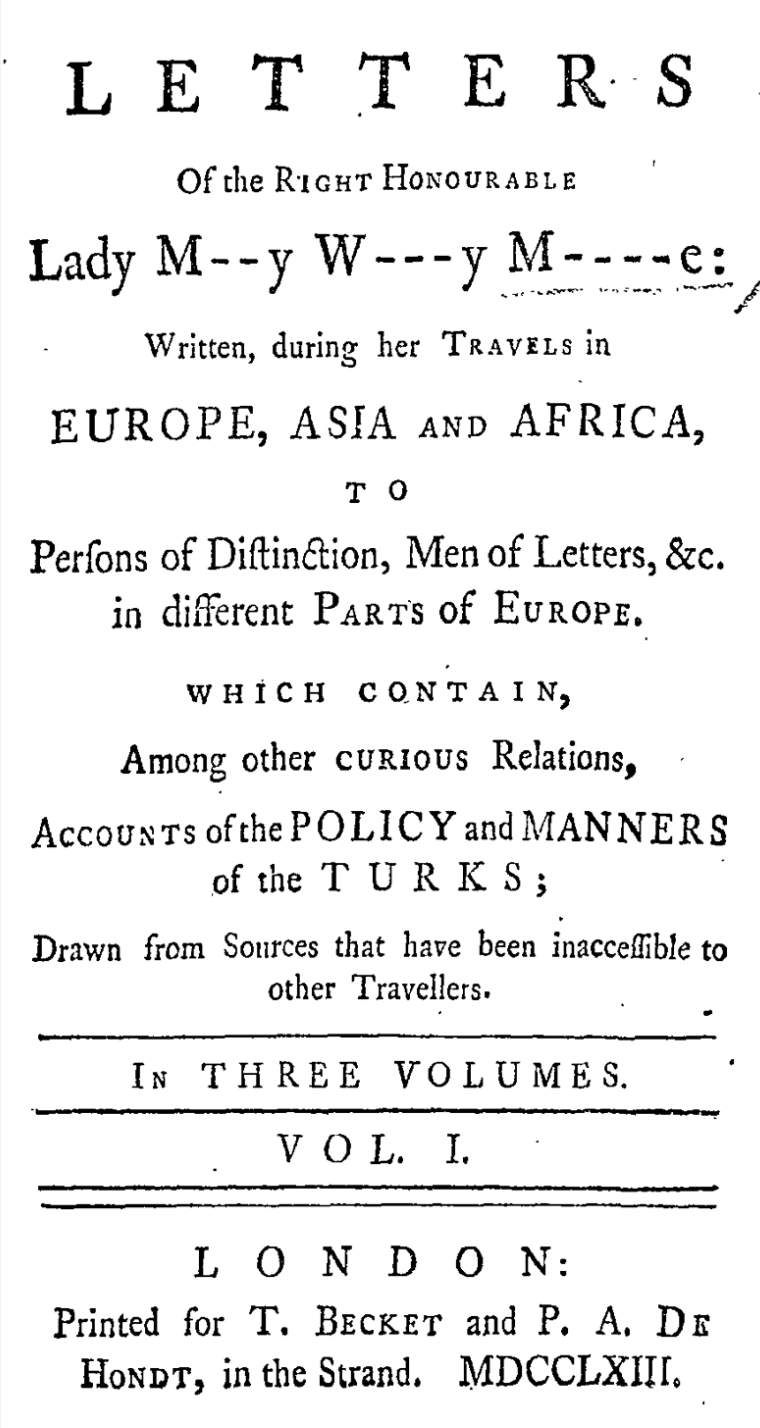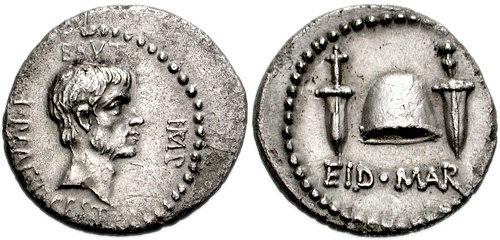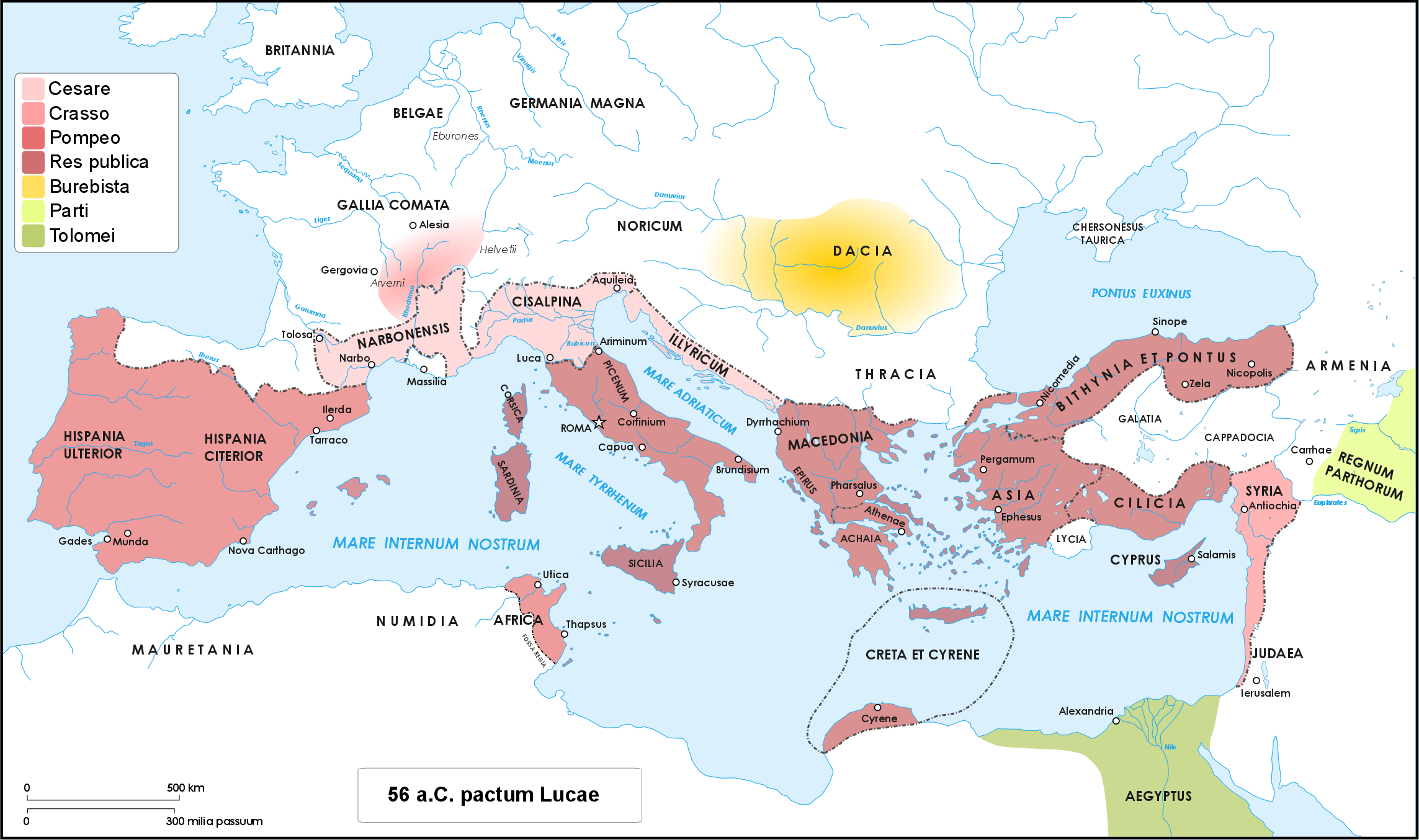|
Epistulae Ad Brutum
''Epistulae ad Brutum'' (''Letters to Brutus'') is a collection of letters between Roman politician and orator Marcus Tullius Cicero and fellow politician, and conspirator against Julius Caesar, Marcus Junius Brutus. The letters in this collection, when combined with Cicero's other letters, are considered some of the most reliable sources of information for the period leading up to the fall of the Roman Republic. Cicero became acquainted with Brutus through his close friend Titus Pomponius Atticus, an admirer of Brutus. Their personal relationship likely grew during their time together in opposition to Caesar during the civil war in 49 BCE, it being firmly established by the time Cicero returned to Rome in the autumn of 47. Traditionally divided into two books, the collection features 26 letters written from March or April to July 43 BCE — a year after the assassination of Julius Caesar, and a year before the death of Brutus in 42. The authenticity of the letters was ... [...More Info...] [...Related Items...] OR: [Wikipedia] [Google] [Baidu] |
Collection Of Letters
A letter collection consists of a publication, usually a book, containing a compilation of letters written by a real person. Unlike an epistolary novel, a letter collection belongs to non-fiction literature. As a publication, a letter collection is distinct from an archive, which is a repository of original documents. Usually, the original letters are written over the course of the lifetime of an important individual, noted either for their social position or their intellectual influence, and consist of messages to specific recipients. They might also be open letters intended for a broad audience. After these letters have served their original purpose, a letter collection gathers them to be republished as a group. Letter collections, as a form of life writing, serve a biographical purpose. They also typically select and organize the letters to serve an aesthetic or didactic aim, as in literary belles-lettres and religious epistles. The editor who chooses, organizes, and sometime ... [...More Info...] [...Related Items...] OR: [Wikipedia] [Google] [Baidu] |
Rhetoric
Rhetoric is the art of persuasion. It is one of the three ancient arts of discourse ( trivium) along with grammar and logic/ dialectic. As an academic discipline within the humanities, rhetoric aims to study the techniques that speakers or writers use to inform, persuade, and motivate their audiences. Rhetoric also provides heuristics for understanding, discovering, and developing arguments for particular situations. Aristotle defined rhetoric as "the faculty of observing in any given case the available means of persuasion", and since mastery of the art was necessary for victory in a case at law, for passage of proposals in the assembly, or for fame as a speaker in civic ceremonies, he called it "a combination of the science of logic and of the ethical branch of politics". Aristotle also identified three persuasive audience appeals: logos, pathos, and ethos. The five canons of rhetoric, or phases of developing a persuasive speech, were first codified in classical Rome: i ... [...More Info...] [...Related Items...] OR: [Wikipedia] [Google] [Baidu] |
1st-century BC Books In Latin
File:1st century collage.png, From top left, clockwise: Jesus is crucified by Roman authorities in Judaea (17th century painting). Four different men ( Galba, Otho, Vitellius, and Vespasian) claim the title of Emperor within the span of a year; The Great Fire of Rome (18th-century painting) sees the destruction of two-thirds of the city, precipitating the empire's first persecution against Christians, who are blamed for the disaster; The Roman Colosseum is built and holds its inaugural games; Roman forces besiege Jerusalem during the First Jewish–Roman War (19th-century painting); The Trưng sisters lead a rebellion against the Chinese Han dynasty (anachronistic depiction); Boudica, queen of the British Iceni leads a rebellion against Rome (19th-century statue); Knife-shaped coin of the Xin dynasty., 335px rect 30 30 737 1077 Crucifixion of Jesus rect 767 30 1815 1077 Year of the Four Emperors rect 1846 30 3223 1077 Great Fire of Rome rect 30 1108 1106 2155 Boudican re ... [...More Info...] [...Related Items...] OR: [Wikipedia] [Google] [Baidu] |
Lorsch Abbey
Lorsch Abbey, otherwise the Imperial Abbey of Lorsch (; or ''Laurissa''), is a former Imperial abbey in Lorsch, Germany, about east of Worms, Germany, Worms. It was one of the most important monasteries of the Carolingian Empire. Even in its ruined state, its remains are among the most important pre-Romanesque architecture, Romanesque–Carolingian architecture, Carolingian style buildings in Germany. Its chronicle, entered in the ''Lorsch codex, Lorscher Codex'' compiled in the 1170s (now in the state archive at Würzburg), is a fundamental document for early medieval German history. Another famous document from the monastic library is the Codex Aureus of Lorsch, ''Codex Aureus'' of Lorsch. In 1991 the ruined abbey was listed as a UNESCO World Heritage Site because of its architectural and historical importance. The significant remains visible today are the 9th-century ''Torhalle'' (gatehouse), part of the abbey church, some of the wall around the abbey, and other walls and ... [...More Info...] [...Related Items...] OR: [Wikipedia] [Google] [Baidu] |
Sichardus
Sicard, Sicardo, Sicardus, Sichard or Sicart is a given name of Germanic origin. It may refer to: * Sicard of Benevento (died 839), prince of Benevento * Sichard (died 842), abbot of Farfa * Sicard of Cremona (1155–1215), bishop of Cremona * Bernart Sicart de Maruèjols (fl. 1230), troubadour * Sicart de Figueiras (fl. 1290), Cathar bishop * Sicard de Lordat Sicard de Lordat was a 14th-century architect from the County of Foix, now in modern-day France, who worked for Gaston Fébus (Gaston III of Foix-Béarn). He is noted particularly for working with brick, a material that was cheap and allowed speed ... (fl. 14th century), architect from the County of Foix {{given name Germanic given names ... [...More Info...] [...Related Items...] OR: [Wikipedia] [Google] [Baidu] |
Basel
Basel ( ; ), also known as Basle ( ), ; ; ; . is a city in northwestern Switzerland on the river Rhine (at the transition from the High Rhine, High to the Upper Rhine). Basel is Switzerland's List of cities in Switzerland, third-most-populous city (after Zurich and Geneva), with 177,595 inhabitants within the city municipality limits. The official language of Basel is Swiss Standard German and the main spoken language is the local Basel German dialect. Basel is commonly considered to be the cultural capital of Switzerland and the city is famous for its many Museums in Basel, museums, including the Kunstmuseum Basel, Kunstmuseum, which is the first collection of art accessible to the public in the world (1661) and the largest museum of Swiss art, art in Switzerland, the Fondation Beyeler (located in Riehen), the Museum Tinguely and the Museum of Contemporary Art (Basel), Museum of Contemporary Art, which is the first public museum of contemporary art in Europe. Forty museums ... [...More Info...] [...Related Items...] OR: [Wikipedia] [Google] [Baidu] |
Andreas Cratander
Andreas Cratander (born Andreas Hartmann in Strasbourg, ca. 1490; died 1540) was a Swiss printer, publisher, and book seller. Based in Basel, his workshop is estimated to have published at least 150 individual works between 1518 and 1535, predominantly Latin and Greek classics in their original languages. Education and Work He studied at the University of Heidelberg, where he graduated with a baccalaureate. After he learned the ropes in the workshop of the printer Matthias Schürcher in Strasbourg. From 1515 he worked for Adam Petri in Basel. In 1518, he opened his own print and from 1522 employed the later reformator of Basel Johannes Oecolampadius. Oecolampadius would also lodge in his house. He published a reprint of the commentaries to the Evangeliums of Jacques Lefèvre d'Étaples in 1523 whose cover was adorned with a metalcut of Hans Holbein the Younger, signed by Jacob Faber. Lefèvre was so impressed, he gave Cratander his commentaries to the letters of the New Test ... [...More Info...] [...Related Items...] OR: [Wikipedia] [Google] [Baidu] |
Augustus
Gaius Julius Caesar Augustus (born Gaius Octavius; 23 September 63 BC – 19 August AD 14), also known as Octavian (), was the founder of the Roman Empire, who reigned as the first Roman emperor from 27 BC until his death in AD 14. The reign of Augustus initiated an Roman imperial cult, imperial cult and an era of regional hegemony, imperial peace (the or ) in which the Roman world was largely free of armed conflict. The Principate system of government was established during his reign and lasted until the Crisis of the Third Century. Octavian was born into an equites, equestrian branch of the plebeian Octavia gens, Octavia. Following his maternal great-uncle Julius Caesar's assassination of Julius Caesar, assassination in 44 BC, Octavian was named in Caesar's will as his Adoption in ancient Rome, adopted son and heir, and inherited Caesar's name, estate, and the loyalty of his legions. He, Mark Antony, and Marcus Lepidus formed the Second Triumvirat ... [...More Info...] [...Related Items...] OR: [Wikipedia] [Google] [Baidu] |
Assassination Of Julius Caesar
Julius Caesar, the Roman dictator, was assassinated on the Ides of March (15 March) 44 BC by a group of senators during a Roman Senate, Senate session at the Curia of Pompey, located within the Theatre of Pompey in Ancient Rome, Rome. The conspirators, numbering between 60 and 70 individuals and led by Marcus Junius Brutus, Gaius Cassius Longinus, and Decimus Junius Brutus Albinus, stabbed Caesar approximately 23 times. They justified the act as a preemptive defense of the Roman Republic, asserting that Caesar's accumulation of lifelong political authority—including his perpetual dictatorship and other honors—threatened republican traditions. The assassination failed to achieve its immediate objective of restoring the Republic's institutions. Instead, it precipitated Caesar's posthumous Roman imperial cult, deification, triggered the Liberators' civil war (43–42 BC) between his supporters and the conspirators, and contributed to the collapse of the Republic. These ev ... [...More Info...] [...Related Items...] OR: [Wikipedia] [Google] [Baidu] |
Ancient Rome
In modern historiography, ancient Rome is the Roman people, Roman civilisation from the founding of Rome, founding of the Italian city of Rome in the 8th century BC to the Fall of the Western Roman Empire, collapse of the Western Roman Empire in the 5th century AD. It encompasses the Roman Kingdom (753–509 BC), the Roman Republic (50927 BC), and the Roman Empire (27 BC476 AD) until the fall of the western empire. Ancient Rome began as an Italic peoples, Italic settlement, traditionally dated to 753 BC, beside the River Tiber in the Italian peninsula. The settlement grew into the city and polity of Rome, and came to control its neighbours through a combination of treaties and military strength. It eventually controlled the Italian Peninsula, assimilating the Greece, Greek culture of southern Italy (Magna Graecia) and the Etruscans, Etruscan culture, and then became the dominant power in the Mediterranean region and parts of Europe. At its hei ... [...More Info...] [...Related Items...] OR: [Wikipedia] [Google] [Baidu] |
Caesar's Civil War
Caesar's civil war (49–45 BC) was a civil war during the late Roman Republic between two factions led by Julius Caesar and Pompey. The main cause of the war was political tensions relating to Caesar's place in the Republic on his expected return to Rome on the expiration of his Lex Vatinia, governorship in Roman Gaul, Gaul. Before the war, Caesar had led an Gallic Wars, invasion of Gaul for almost ten years. A build-up of tensions starting in late 50 BC, with both Caesar and Pompey refusing to back down, led to the outbreak of civil war. Pompey and his allies induced the Roman Senate, Senate to demand Caesar give up his provinces and armies in the opening days of 49 BC. Caesar refused and instead Crossing the Rubicon, marched on Rome. The war was fought in Italy, Illyria, Greece in the Roman era, Greece, Ptolemaic Egypt, Egypt, Africa (Roman province), Africa, and Hispania. The decisive events occurred in Greece in 48 BC: Pompey defeated Caesar at the Battle of ... [...More Info...] [...Related Items...] OR: [Wikipedia] [Google] [Baidu] |
Titus Pomponius Atticus
Titus Pomponius Atticus (November 110 BC – 31 March 32 BC; later named Quintus Caecilius Pomponianus Atticus) was a Roman editor, banker, and patron of letters, best known for his correspondence and close friendship with prominent Roman statesman Marcus Tullius Cicero. Atticus was from a wealthy Roman family of the equestrian class (lower aristocratic non-ruling class) and from the Pomponia gens. A close friend since childhood, Cicero dedicated his treatise, , to Atticus. Their correspondence, often written in subtle code to disguise their political observations, is preserved in (''Letters to Atticus'') compiled by Tiro, Cicero's slave (later his freedman) and personal secretary. Biography Early life Born Titus Pomponius in Rome , Atticus' parents were Titus Pomponius, a wealthy businessman, and Caecilia. His family were equestrians and likely had been members of the prestigious equestrians with public horse () for many generations. He had a sister named Pomponia ... [...More Info...] [...Related Items...] OR: [Wikipedia] [Google] [Baidu] |







